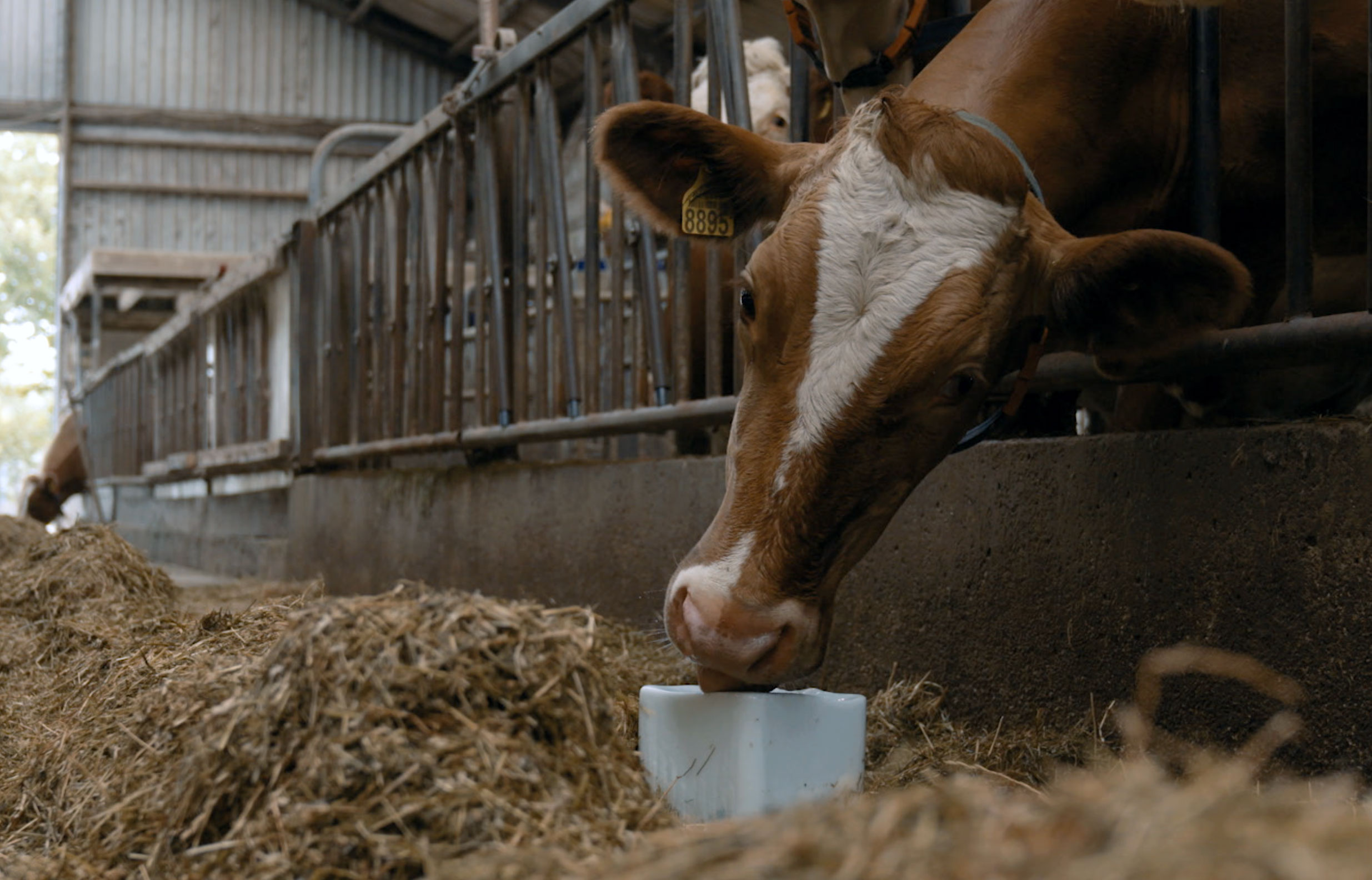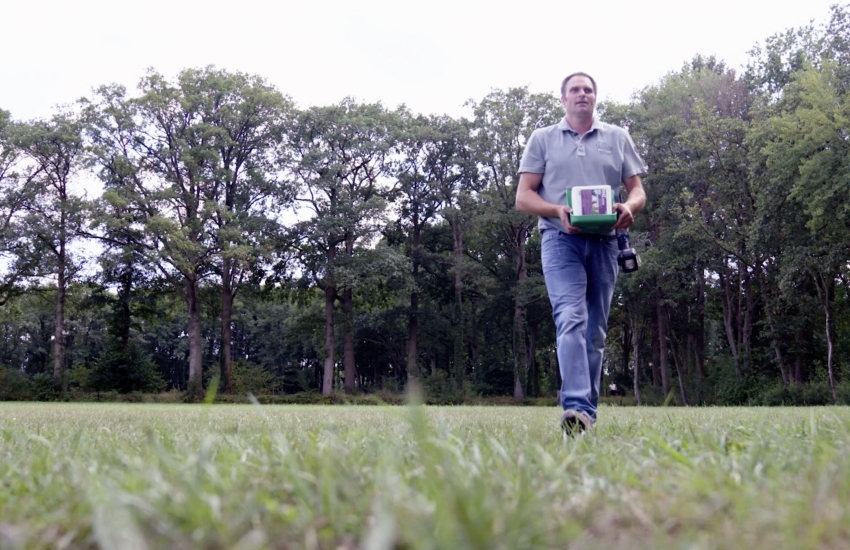
Dairy farmer Prawes from Thailand: “We believe in the quality of KNZ”
About 15 years ago, Prawes Angsakul and his wife took over the Prateung dairy farm from their parents, as the second generation. Their goal is to develop and improve the farm, including the barns and farm management, to ensure their calves grow into good and healthy dairy cows.
We believe in the quality of KNZ
Prateung Farm is located in the Muak Lek subdistrict of Saraburi in Thailand. Prateung Farm has around 350 cows and distributes raw milk to the Thai-Denmark Dairy Cooperative Lamphaya Klang Company Limited, of which Prawes is president. Quality is paramount at Prateun Farm. Only the best is good enough.

Good health and high productivity
To boost production, Prateung Farm uses KNZ Universal licks for their cows, from the calves to mature dairy cows. “We choose KNZ licks because of the importance of supplementing cows with salt and various minerals for good health and to ensure high productivity,” Prawes mentions. “We have relied on KNZ licks for over 15 years. We trust the source of KNZ salt, in Europe, and believe in the high quality of KNZ based on long experience.” For Prateung Farm this results in the farm’s cows showing no signs of salt or mineral deficiency, significantly reducing problems with the breeding system and maintaining their overall health.
“We choose KNZ licks because of the importance of supplementing cows with salt and various minerals for good health and to ensure high productivity”
Superior quality
Prawes has tried other brands as well; “I tried to switch to other brands of mineral blocks as well, but I ultimately returned to KNZ because its quality is truly superior.” When asked if Prawes would advise fellow farmers to use KNZ licks he is very clear: “Without a doubt, I will recommend that fellow members of the cooperative use KNZ because of its excellent quality. It’s definitely the most worthwhile choice!”
Justine van der Meij on KNZ Licks
Justine is "living her dream," as she describes herself. She has a dairyfarm in Woudenberg (the Netherlands). Her 66 cows benefit from a little extra in their diet: KNZ licks.
The right lick for each life stage
Justine chooses the KNZ Standard lick for adult cows and the KNZ Junior for young stock. "This way we meet the needs of each life stage. A good mineral supply is crucial for the health and well-being of cows. Salt licks are essential to achieve this," she explains. "I see the cows enjoying the licks. This stimulates their natural behavior and provides them with essential minerals."

Happy cows, happy farmer
Justine uses a lickholder to make it easier for the cows to consume the lick. ‘’The lickholder has benefits for both the cows and for me. The lick gets never in the way, I can easily check if they need a new one and the lick doesn’t get dirty.’’ Justine places the lick next to the water bowl. In that way the cows can choose how much salt they want to take. ‘’When cows use the lick they drink more water, which is important for a good milk production’’.
Valuable addition
Justine recommends KNZ licks for farmers striving for good health and productivity of their herd. "Due to their beneficial effects on well-being and behavior, KNZ licks are a valuable addition. They are crucial for balanced nutrition management."
Do you want to improve the health and productivity of your livestock? KNZ licks offer the solution. View our products to learn more about how they contribute to more efficient farming.
Jan-Jaap Verweij (Jacob’s Farm) on KNZ licks
Dutch dairy farmer Jan-Jaap Verweij has 55 dairy cows that are milked with the help of a milking robot. He says, "A lick is a nice addition for animals that need it."
The ideal amount
Jan-Jaap previously experimented with salt/vitamin boluses but soon realized it was not necessary. "It may have even been too much." The concentrate feed that the cows receive contains minerals and vitamins. "We offer licks to the cows that have extra needs. With licks, you don't have to worry about them getting too much. Additionally, putting out a lick is much easier than administering boluses."

First needs after milking
Jan-Jaap strategically placed the licks at the exit of the milking robot, next to the water trough. "After milking, cows first need enough water and can then take a few licks of the salt block. They have a need for it," Jan-Jaap observes. The cows use one block for about 5-6 days. In winter, this often goes even faster at Jacob's Farm.
"You don't have to worry about them getting too much with KNZ licks."
Always provided with salt
Jan-Jaap temporarily didn't offer licks and noticed that the cows still had a need for it. After the licks were put back, the cows used them at a rapid pace. To prevent the cows from running out, Jan-Jaap now always puts two licks in the barn.
Jan-Jaap believes it's important for his cows to feel good and to receive the minerals and vitamins they need in a natural way. Licks are a nice way to contribute to this. "Besides, it's still a beautiful sight to see a cow indulge in a lick."
Eric Pottier on KNZ salt licks for sheep
Eric Pottier runs a biological grassland farm, together with his family. On 83 hectares they raise 40 dairies and 200 suckling ewes. Eric chose for the KNZ salt licks for complementation, as these licks are most resistant and durable under all conditions. Eric finds it important to work with licks enriched with selenium, especially for sheep during late gestation and lactation.
Paula Koomen on KNZ salt licks
In the North Holland village of Spierdijk, Paula and Kees Koomen run their dairy farm with 125 dairy cows and a total of 200 cattle. "We have been milking the cows with a milking robot for a year now and it's going very well," says Paula. "We choose the right diet by looking closely at the health of our cows; we do it by feel. Fresh grass, silage, maize and concentrated feed along with salt and minerals form a balanced diet."
Salt from mixer trucks or salt licks?
On the mts farm. The Koomens are convinced that adding salt through the feed mixer truck does not meet the individual needs of the cows. "We think that adding salt using the mixer truck does not meet the individual needs of our cows. We would rather have salt available to the cows that need it through the licks."
"Meeting the individual salt needs of our cows"
Easy to use
"We use KNZ salt licks with the feed because we find that the most convenient system, allowing the cows that need it to get their salt." The salt needs of cows are determined by their weight, their lactation phase and the ambient temperature. The cows perspire more in hot weather and therefore need more salt. Paula explains more about this: "We use the salt licks all year round, but in the summer months when it is very hot, we put extra licks near the cows so that they can get enough salt." Paula is also very satisfied with the quality of KNZ salt licks: "They stay quite hard, they don't fall apart, we put them in front of the feed fence and the cow does the rest."

Anne Harmsen on KNZ salt licks
Anne Harmsen of mts. Harmsen from Apeldoorn runs, together with his wife and brother, the dairy farm with 80 dairy cattle and their young cattle. When the season is right, the cows just roam the fields and in the evenings they go to the stable, where they receive their standard ration of maize, grass, concentrate, minerals and salts.
Free acces to salt and minerals
They have been using KNZ's licks on the farm from early on. The salt licks are hung in the pasture and close to the automatic feeder using the specially designed holders, giving the cows full access to salt and minerals.
"Always exactly the right amount of salt and mineral"
An essential part of their diet
Did you know that salt and minerals are an essential part of a dairy cow's diet? Dairy cows lose a relatively large amount of salt through milk production. This can quickly lead to deficiencies. Cows with a salt deficiency lose their appetite, grow less and can even lose weight. These cows are less healthy and the salt and mineral deficiency also reduces productivity.
Prevent salt deficiency
Cows with a salt deficiency actively look for salt and minerals in their surroundings. You can recognize these cows by their need to lick and nibble on different materials in the stable, such as wood, steel, the ground, etc. Cows will sometimes also lick each other. "I never worry about salt and mineral deficiencies in my cows," says Harmsen. "My cows always consume exactly the right amount of salt and minerals thanks to KNZ salt licks.

Eric Pottier on KNZ salt licks for cows
Eric Pottier runs a biological grassland farm, together with his family. They took over this farm 7-8 years ago. During the year, they pay extra attention to the supply of salt with the KNZ salt licks, as this is essential. Eric and his family choose KNZ salt licks because of the palatability and the fact that the licks stands well outside and do not disintegrate easily with the climate. Eric noticed a good regulation with the consumption of licks which is variable according to the season, the year and the plot.
Andrea Ruitenberg about KNZ licks
Andrea has been a farmer for nearly 30 years and simply doesn’t know any better than to use KNZ licks for her 65 milking cows. ‘’Everybody knows KNZ is thé brand, right?’’
It really is a habit
From a young age, Andrea dreamed of, what she considers, a delightful existence where you can be your own boss and live among animals. And she succeeded. Since 1995, she has been working on her husband's family dairy farm and is incredibly happy. '’When I first started working here, there were already salt licks in the barn. Specifically, KNZ Standard salt licks. It became a habit for me to add these to the ration. The cows are used to it too and still get the KNZ Standard. Recently they ran out, and you could really tell they were very happy when a new one was available. They would walk over to the salt lick in a little group.’’

It's not just a habit for Andrea, as the salt block has also helped her cows in less ordinary situations. '’A while back, a calf got meningitis. I really didn't know what was wrong, his ear and eye were all droopy. Then we gave him the salt lick, which made him drink more and he recovered. That calf really benefited from the salt. We have also had many cows with udder inflammation. Here too, the lick came in handy and the cows are now happily healthy again.'"
‘’Everybody knows KNZ is thé lick right?’’
Every cow has its own salt needs
According to Andrea, everyone wants the best for their cow. With KNZ salt licks, you give them a little extra they deserve. ‘’You notice that the cows have a certain need for salt and because each animal is different, they can dose themselves with the salt block. It's incredibly easy and it makes the cows happy. Why wouldn't you do it?’’
Do you want to improve the health and productivity of your livestock? KNZ licks offer the solution. View our products to learn more about how they contribute to more efficient farming.
Contact
KNZ Customer service
Boortorenweg 101
7554 RS Hengelo
The Netherlands
Tel: +31(0)74-8080900
info@knzsalt.com
ติดต่อเรา
บริษัท นิวทริไบร์ท จำกัด 16 ซอยพัฒนาการ 51 แขวงสวนหลวง เขตสวนหลวง กรุงเทพฯ ประเทศไทย 10250 Tel : 02-116-6143 admin.1@nutribright.co.th
